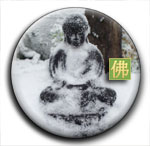On The Way: The Daily Zen Journal
Correct Practice
Chih I (538-597)
If you would like to learn the correct way to do samatha vipasyana stop-look Zen meditation, you must from start to finish work toward refining and eliminating mental images.
There are two kinds of Zen meditation: sitting practice, and, depending on circumstances, practicing samatha-vipasyana while doing other activities. The first way for those who desire to perfect samatha-vipasyana meditation is done while sitting.
Even though there are those who wish to practice it while doing the four modes of activity, walking, standing, sitting, and lying down, and even though one can learn the way of stop-look meditation by all these means, still sitting is the most effective.
You should agree to use sitting first to understand samatha-vapasyana meditation. By definition, there are five different reasons for doing stop-look meditation: to overcome the coarse perturbed mind of the beginner, to heal the heart-mind from depression and agitation, to stabilize your mind when needed, to refine (empty) your heart-mind; and to balance (internal) Zen concentration with (external) wisdom, during the practice of Samatha-vipasyana.
The first reason is to overcome the coarse and tumultuous mind of the beginner. You who are called practitioners, when you first sit in Zen, since your heart and mind are coarse and troubled, you must first practice samatha, for example, concentration or “stopping” the heart-mind, in order to master them. If this doesn’t work, then you must practice vipasyana “looking.”
This is why you are told “to overcome the beginner’s coarse and troubled mind, practice ‘stop’ and ‘look.'” Now if you want to understand what “stop” and “look” mean, you realize they are two different notions. First, you must understand how to practice stopping the mind, then practice looking.
Samatha means to “stop” mental images and the heart’s desires during meditation. There are three kinds of samatha, stopping and focusing the mind. The first is to bind the mind’s focus to a single spot, such as fixing attention on the tip of the nose or the place just below the navel, not allowing the heart-mind to wander from it.
Thus one of the Sutras says:
The bound mind that cannot wander
Is like a monkey chained to a post.
The second kind of samatha controls the mind from wandering after any thoughts that might occur; for example, it is easy to control the mind when you don’t let it gallop away. Thus it is said:
The five sense roots
(eyes, ears, nose, taste, touch)
are all governed by the heart-mind.
So you must guard it well
The above two kinds of samatha are both concerned with the phenomenal (concepts and impressions within the mind arising from sense contact with the outer noumenal reality.) They should not be separated.
The third kind of samatha focuses on the true essence or Tathagata essence, for example, the suchness essence of the Buddha nature. The so-called “letting the mind follow whatever thought arises,” all of the dharmas, all these things, you must know, are born from direct and conditioned causes, and have no substantial nature of their own. Thus the heart mind does not actually hold onto them.

If your heart does not really grasp them, then relinquish the wrongly conceived. This is called samatha (stopping concepts).
As one of the sutras puts it:
All the many Dharmas,
Their causes and conditions
Are empty, without master.
Let heart-mind rest,
In the root source,
Then you will be called
“Sramana!” (monk or practitioner)
You, the practitioner, when you begin to learn Zen, will want to perfect the Buddhas of the Ten Directions, the Buddha Dharma of the Three Worlds, (past, present, future),….and help all sentient beings to cross over and seek the highest transcendent Way.
Your heart must be firm and strong, like the vajra, with diligence and fortitude pressing forward sacrificing your own life and body, but if you don’t attain the goal of enlightenment through Zen stop, look meditation, then in spite of all the Buddha’s Dharma, in the end you will not escape the recycling wheel.
Thereupon, if you desire to sit upright, correctly focusing with the single mind on all Dharma, then your subject of thought will be on the True reality.
What is meant by the term “all Dharma?” It is a contract you make with your heart-mind to understand each and every Dharma. This means that you understand that all good and bad Dharma, all uncategorized Dharma, all worrisome and troubled Dharma, all that exists in the Three Worlds, birthing and dying, all cause and effect Dharma, all of these are caused by the mind.
The Jujikyo Dasabhumika sutra states:
The Three Worlds have no other Dharma
Except that of perfecting the One Mind.
If you the practitioner realize that the mind has no reality of its own, then how can any of the Dharma (things mentally conceived) be real? But if all of the Dharmas are unreal, then they are in fact empty and illusory. If you know they are empty and illusory, then they are also void and without a master.
If void and without a master, then you can’t really hold onto them. Relinquish what can’t be held on to, relinquish the concept and let the mind rest. If you let go of them and rest your mind, then you will abide tranquilly in the state of asamkrita (non-action), which in turn is the basic root of all Dharma.
If one can let the heart rest in the root source (settle the heart in its origins), then it cannot be sullied. The unsullied heart is freed from the fetters of life, death, and karmic deeds. If birth, death, and karmic deeds cease, this is the state of Nirvana.
Thus the Buddhist Scriptures say
If you have a mind that doesn’t know
And a mind that doesn’t see,
That mind-conceiving thought is ill,
Then mind with no thought brings Nirvana.
If in fact you can do this, perfect the mind’s True Nature through cessation, then you will know that humans are meant to attain Nirvana, that which is called “Great Monk’s Gateway (practice).” This is how to explain the way of perfecting True Nature by cessation. True nature is empty, realized in mind’s cessation
Chih I (538-597)
Source – excerpted from Zen is for Everyone – The Xiao Zhi Guan text by Zhi Yi





In this chapter on practice, Chih I covers a tremendous amount of territory. With a simple name like stop-look Zen meditation, we are introduced to a short-hand view of this technique. The straightforward reasons for practice are all ones we can relate to, and perhaps a few are a bit surprising to consider as reasons to practice meditation.
No matter how many years we have sat, however, it is difficult to really feel like more than a beginner, and probably a safe place to linger; beginner’s mind adding a freshness and sense of surprise in discovering things on our own.
To move from just reading to implementation, there is a step we need to take to make the teachings our own. If you were going to try stop look meditation practice, how would you incorporate this practice? Years ago in our practice, we heard a quote from Confucius
Only one who bursts with enthusiasm do I instruct;
Only one who bubbles with excitement do I enlighten.
If I hold up one corner and you do not come back
To me with the other three,
I do not continue the lesson.
Perhaps for us moderns we should modify this to say, if I hold up three corners and you do not come back to me with the last one…
Most of us need more hints and nudges to move forward to take the teachings to the next level, the one where we do something with them!
Seeking that last corner,
Elana. scribe for Daily Zen